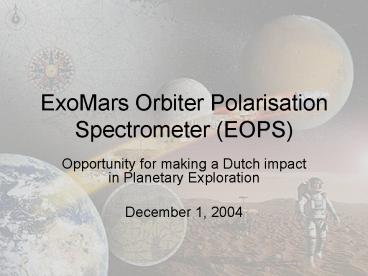ExoMars Orbiter Polarisation Spectrometer EOPS - PowerPoint PPT Presentation
1 / 10
Title:
ExoMars Orbiter Polarisation Spectrometer EOPS
Description:
... of extant/extinct life on Mars. Landing a Rover with Pasteur payload on the surface of Mars ... Periapsis: 300 km, apoapsis: 6300 km (Mars Express equivalent) ... – PowerPoint PPT presentation
Number of Views:22
Avg rating:3.0/5.0
Title: ExoMars Orbiter Polarisation Spectrometer EOPS
1
ExoMars Orbiter Polarisation Spectrometer (EOPS)
- Opportunity for making a Dutch impact in
Planetary Exploration - December 1, 2004
2
Introduction
- ExoMars Mission background
- Orbiter payload opportunity
- Science Case for a Polarisation Spectrometer on
the ExoMars Orbiter - EOPS instrument development
- Outlook
3
ExoMars mission background (1)
- Search for signs of extant/extinct life on Mars
- Landing a Rover with Pasteur payload on the
surface of Mars - ExoMars Orbiter serves as data-relay for rover
- ExoMars rover has lifetime in the order of months
upto a year - Current launchdate 2009
4
ExoMars mission background (2)
- Three consortia have performed a phase A1 study
for the ExoMars mission - Alenia Spazio (Italy) with subcontractors OHB
(Germany), GMV (Spain), SEA (UK), SSC (UK) and
Laben (Italy). - Alcatel Space (France) with subcontractors Deimos
(Spain), ETCA (Belgium), Fluid Gravity
Engineering (UK), Kayser Threde (Germany), Laben
(Italy), MD Robotics (Canada), NGC Aerospatiale
(Canada), QinetiQ (UK), Vorticity (UK). - EADS Astrium (France) with subcontractors Astrium
Ltd. (UK), EADS LV (France) and SAS (Belgium). - Currently, a phase A2 is under study (by at least
Alenia Spazio) which will run till May 2005
5
ExoMars Orbiter Payload opportunity
- ExoMars Mission definition includes provisions
for a payload on-board the orbiter - Mass 20 kg TBC
- Nadir pointed
- Maximum power use 45 W
- Data rate 1 Gbit/day
- Absolute payload pointing accuracy (during
imaging) 20 arcsec - Orbit parameters are not fixed (May 2005).
Options studied - Periapsis 300 km, apoapsis 6300 km (Mars
Express equivalent) - Periapsis 500 km, apoapsis 8919 km (ESA/ESTEC
CDF Study Report ExoMars 09, August 2002) - Circular orbit with altitude 550 km (ExoMars
orbiter with MSR RVE (Rendez Vous Experiment)) - Circular orbit will not cover the poles
(inclination of 50.7 degrees) - Preferred option The highly elliptic orbit
options are polar global coverage within at
least a few days is guaranteed (including poles)
6
Science Case for EOPS (1)
- Main instrument products
- Water-vapour Indication for possible presence of
sub-surface water reservoirs - Methane Ammonium Indication for possible
presence of micro-bacteriological material - Sulphur-dioxide Indication for possible volcanic
activity and presence of hydro-thermic vents - Dust properties of the atmosphere key factor in
thermal balance of atmospheres and lifetime of
the ExoMars rover - Search for signs of extant/extinct life on Mars
from Mars Orbit, in synergy with the Exomars
rover - Obtain polarisation and absolute flux information
of the reflected sun irradiance from the Martian
atmosphere - Doing climate research on Mars is relevant for
knowledge of Earths climate. The Mars atmosphere
is a relatively simple system compared to Earths
atmosphere and specific effects can be studied in
an isolated case (comparitive planetology). - Prepare instrumentation for search of signs of
life on exoplanets (DARWIN)
7
Science Case for EOPS (2)
- PFS on MEX has shown correlation between
water-vapour and methane - EOPS will provide confirmation, with lower
detection limits and higher ground-resolution - (source http//www.esa.int/esaCP/SEMAK21XDYD_inde
x_0.html)
8
EOPS instrument development (1)
- Based on strong instrument heritage
- OMI (GOME, SCIAMACHY)
- Planetary Fourier Spectrometer (PFS) on-board MEX
VEX - PACE
- Instrument trade-offs to be performed
- Multi-telescope vs single telescope (alignment
vs polarisation calibration) - Prism vs Grating vs Interferometer
- CCD vs CMOS
- Instrument keywords
- Miniaturization
- Employable for all planetary atmospheres (Earth,
Venus, Titan, ..)
9
EOPS instrument development (2)
- Possible instrument configuration
- 3 OMI telescopes with differently aligned
polarisers (S, P, 45 degrees) in crosspoint of
FOV just before primary telescope mirror - 3 slits imaged with same collimator and camera on
CMOS 2d-detector (spectral x spatial). Delicate
baffling required for elimination of straylight
ghosts. - Possible suppliers of CMOS detectors
- Sofradir
- Rockwell
- Miniaturisation
- Use of immersed gratings in echelle mode
- Optimization of spectral windows
Spectrometer
Command
Detector
DataHandling Unit
10
Outlook
- Dutch role in Mars exploration appeals to the
society in general. - Dutch role in Mars Exploration will increase
interest in technical studies - Opportunities for International Partnerships
- Italy is main contributor to Aurora programme
- Possible partnerships
- Institutes IFSI, IRSPS, TBD
- Industry Alenia Spazio, Galileo Avionica (who
built GOME) - Need for urgent team build-up launch is
prospected in 2009! - 0.5 year feasibility study should minimally
deliver - Science Requirements
- Signal to noise analysis
- Instrument baseline (telescope, spectrometer,
detectors) - Critical items listing (immersed grating in
echelle mode, polarisers, ) - Development plan

